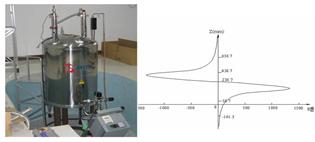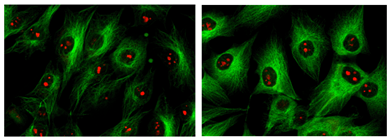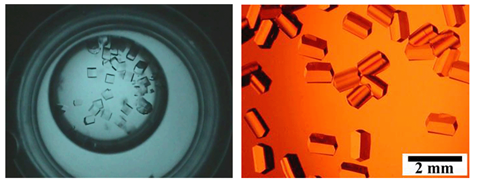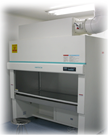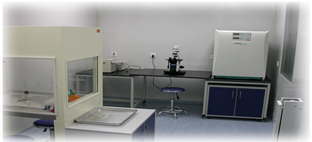Department
Brief Introduction to the Central Laboratory of School of Life Sciences
The Central Laboratory of School of Life Sciences was established in May 2005. Under the guidance of the general construction idea of "High starting point, high level and distinctive", the large-scale instrument and equipment supporting platform for life science research was built by drawing lessons from the construction experience of life science laboratory at home and abroad and combining the characteristics of education and scientific research of Northwest Polytechnical University (NPU). In 2007, the "Laboratory of Space Bioscience and Biotechnology" of NPU became the first batch of key discipline laboratories of the National Defense Science and Technology Commission, and was named "Key Laboratory for Space Bioscience and Biotechnology". The central laboratory is an important part of it. In the same year, the central laboratory became the first pilot unit for the open sharing of large-scale instruments and equipment of NPU. In 2015, the center officially became the open sharing unit of large-scale instruments and equipment of NPU, and its name was changed to “Experimental Sharing Center of Life Sciences”.
The central laboratory is equipped with a high-magneto gravitational environment (HMGE) lab, an analytical instrument lab, a precision optical instrument lab, a cleanroom (including biosafety 2+ laboratory, cell culture cleanroom, animal cleanroom with specific pathogen free (SPF)), and a cleaning and disinfection room. The total value of existing instruments and equipment is more than 42 million yuan, of which 11 sets are more than 1 million yuan. The diamagnetic levitation superconducting magnet (16T) that can be used to simulate the weightlessness effect in space flight and conduct magnetic science research is the world's leading and the only domestic similar equipment; confocal laser scanning microscopy (CLSM), gene chip scanner system, optical knife/optical tweezers, atomic force microscope, coolant-free superconducting magnet, X-ray diffractometer, automatic microbial identification system, dual energy x-ray absorptiometry, automatic pipetting workstation, atomic absorption spectrometer, ultracentrifuge, flow cytometry, etc. are all world-class equipment.
Since its establishment, the central laboratory has made bold explorations and attempts in laboratory management, established the service management concept of "Opening and sharing, scientific management, excellent service, facing the whole school and serving the society", to actively promote the open sharing of equipment. Functions and positioning of the center are as: instrument and equipment supporting, technical services, scientific research and teaching sharing platform. It is the core work of laboratory management to make the platform open and share and provide high quality and efficient technical services for scientific research and teaching. The central laboratory pays attention to the construction of management system and devotes itself to improving the technicians' experimental level and the management level of instruments and equipment. It not only ensures the convenience and quickness of the use of instruments, but also ensures the good operation of equipment and the steady improvement of the utilization rate of equipment. Since its establishment, the center has not only provided good technical services for the professional laboratories of School of Life Sciences, but also provided shared services for other colleges of NPU, as well as many universities and scientific research institutes in Xi'an and other regions.
List of Cell Bank
|
Lab of Precision Optical Instrument
Lab of precision optical instrument is one of the characteristic laboratories of the central laboratory. Confocal laser scanning microscopy, optical tweezers system, atomic force microscopy, inverted/forward fluorescence microscopy, ultra-depth-of-field three-dimensional digital microscopy, stereoscopic microscopy and other advanced optical observation imaging equipment in this lab can meet the needs of life science researches. The total value of these instruments and equipment is nearly 8 million yuan. The combination of optical tweezers and optical knives can achieve various micro-manipulation and micro-processing, such as particle capture, pulling, cutting and drilling. It provides the possibility for micron-scale biological research, and is also an important tool for the study of single cell or organelles in the fields of cell biology, molecular genetics, immunology, genetic engineering, biological spectroscopy and so on. Atomic force microscopy has many imaging modes, which can analyze and characterize the surface morphology, structure and properties of specimens. It is widely used in materials science, chemistry, biomedicine and other disciplines. Confocal laser scanning microscopy can collect fluorescent labeling signals in tissues or cells, observe the changes of the concentration of important ions at the subcellular level and the morphological changes of tissues or cells and their internal micro-structures, perform a tomographic scan of the sample and reconstruct and analyze the three-dimensional structure of the tissue or cell.

Confocal laser scanning microscopy (LSCM) is an analyzer in the field of molecular cell biology developed in the 1980s. It is a new generation of microscopy with the rapid development of laser, video and computer technology. Compared with traditional microscopy, it has incomparable advantages, such as high spatial resolution, non-invasive continuous optical section, three-dimensional imaging, real-time dynamic analysis and detection of cell structure and function.
The image below shows that atomic force microscopy has nanometer imaging resolution, simple sample processing and good field operation. It can work in vacuum and atmosphere as well as directly imaging in solution environment close to physiological conditions. The Pierre-Newton force resolution makes it possible to measure intermolecular/intramolecular forces or molecular manipulation at the single-molecule level.
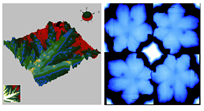
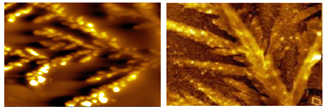
Lab of Analytical Instrument
The lab of analytical instrument is composed of three rooms, one of which is the chemical analysis area. It can carry out precision weighing, spectral analysis, chromatographic analysis, ELISA and other experiments. Instruments in this lab include high performance liquid chromatography, gas chromatography, multimode reader, ultraviolet/visible spectrophotometer, fluorescence spectrophotometer, particle size analyzer/ZETA potentiometer and various types of analytical balance. The second room of analytical instrument can carry out various biological analysis. It can be used for protein analysis and purification, protein electrophoresis, PCR, gel imaging, flow cytometry and so on. There are flow cytometry, two-dimensional electrophoresis analysis system, dual infrared imaging system, medium pressure chromatography system, low-pressure chromatography system, automatic gel imaging analysis system, real-time qPCR instrument and atomic absorption spectrometer. Analytical instrument room 3 is a room for placing centrifuge. Various types of centrifuges installed can meet different experimental requirements. It has large capacity centrifuges, allowing simultaneous centrifugation of 4000 ml samples; high-speed centrifuges for various orifice plates at low and normal temperatures, and ultra-high-speed centrifuges with a maximum speed of 100,000 rpm. The main instruments placed in the centrifuge room are: ultra-speed centrifuge, large capacity & high-speed refrigeration centrifuge, tabletop low-temperature & high-speed centrifuge, high-speed refrigeration centrifuge, freeze-dryer, etc.
Lab of High-magneto Gravitational Environment
This lab has three superconducting magnets, including two diamagnetic levitation superconducting magnets (JMT16T50F) and one coolant-free superconducting magnet. The maximum magnetic induction intensity of the diamagnetic levitation superconducting magnet is 16T, the magnetization level B (dB/dz) can reach -1500T2/m~1100T2/m, by which the gravity conditions from weightlessness to hypergravity (0G-2G) can be simulated, and the apparent gravity conditions at different levels can be simulated stably. It provides simulation experimental conditions for gravity-related scientific research in the fields of life science, material science, physics, chemistry, fluid mechanics, combustion and so on. The superconducting magnet is the leading magnet in the world and the only magnet with diamagnetic levitation ability in China at present. In this laboratory, the diamagnetic levitation characteristics of the superconducting magnet were used to simulate the microgravity environment in space, in which cells and small model animals were cultured for space biology research. The working aperture of the coolant-free superconducting magnet is 150 mm, which can produce a stable magnetic field of 0-12 T. All kinds of scientific experiments under steady magnetic field can be carried out. The laboratory provides an experimental platform for the study of biological effects from weak magnetic field to ultra-high-intensity magnetic field by using a self-made equipment for cell and animal culture.
The superconducting magnet (JMT16T50F) in this lab has the ability to levitate diamagnetic substances such as biology and water. The magnet is the third superconducting magnet with levitation ability in the world, and is the only magnet with levitation ability in China at present.
Researches by Using Superconducting Magnet Ÿ Biological effects of HMGE at molecular and cellular level: The systematic effects of HMGE on cell structure and function and the biological mechanism at molecular and cellular level were studied. (Project of NFSC: "Systematic Study on the Effect of Large Gradient and High-intensity magnetic field on the Structure and Function of Tumor Cells", No. 30670520, Shang Peng)
Effects of high magnetic-weightlessness on the cytoskeleton of osteoblasts Ÿ Model organisms study under HMGE: The effects of HMGE on the whole embryonic development and gene expression profile of model organism silkworm were studied.
Effects of weightlessness simulated by HMGE on embryo development of silkworm Ÿ Crystal growth of biological macromolecules: The mechanism and potential applications of crystal growth under HMGE are studied in this field, which can provide a reference for finding high-quality protein crystal growth pathways. (Project of NFSC: "Research on Crystallization Process of Biomacromolecule in Large Gradient and High-intensity magnetic field", No. 30570384, Yin Dachuan)
Effects of weightlessness simulated by HMGE on protein crystal growth |
Brief Introduction of Biosafety II + (BSL-2+) Laboratory
The design and construction of this lab are according to the General Requirements for Laboratory Biosafety (GB19489-2004) and the WHO Laboratory Biosafety Manual (April 2003 Revision) (ISO/DIS 14644-1) and other current standards. The laboratory covers an area of about 60 m2. It has a first dressing room, second dressing room, buffering room, core experimental area and independent monitoring room with a cleanliness of 100,000. The core area of the laboratory is about 25 m2. The laboratory is equipped with biological safety cabinet, CO2 incubator, bacterial incubator, centrifuge, refrigerator and sterilizer. The whole BSL-2+ laboratory has a reasonable pressure gradient between the districts, and the temperature and humidity are suitable for automatic control. The air in the laboratory is filtered and discharged by high-efficiency filters, which will not cause harm to the surrounding environment. The laboratory can satisfy the research of infectious biology experiments involving harmful pathogenic microorganisms in the life sciences such as space biology and space biotechnology.
SPF/ Animal Clean Laboratory The SPF/Clean Animal Laboratory covers an area of about 40 m2. It is divided into preparation room, SPF Animal Laboratory, Clean Animal Laboratory, Clean Animal Feeding Observation Room and Clean Feed Storage Room with a cleanliness of 10,000. SPF Animal Laboratory has an independent air supply aseptic animal cage (IVC). The cleanliness of the cage is 100, and it is isolated from the outside world. It can eliminate animal infections and cross infections to the greatest extent. The behavior of laboratory animals can be observed by monitoring system in the observation room of clean animal feeding.
Brief Introduction of Cell Culture Cleanroom Cell culture clean room is divided into two independent cell culture laboratories, four culture rooms, with a total area of 80 m2 and a cleanliness of 100,000 grades. Inside, CO2 incubator, ultra-clean worktable, inverted microscope, centrifuge, refrigerator, random positioning machine and other supporting equipment can accommodate nearly 20 researchers to carry out cell culture research at the same time. The clean room also introduced dozens of standardized cell lines, which can meet the research needs of space cell biology, space pharmacology and tumor cell biology.
|
Charging Standard for Sharing Instruments and Equipment in Central laboratory of School of Life Sciences
|
Contact Us Tel: +86-29-8849184 Fax: +86-29-88460332 E-mail: life@nwpu.edu.cn
Address: 127 West You Yi Road Xi’an Shaanxi, 710072, P.R. China

